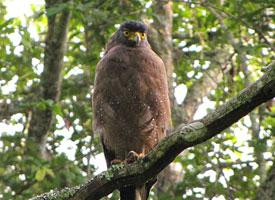
Weights and measures
| Length | from 55 to 75 cm |
|---|
Animal description
The Sulawesi serpent eagle (Spilornis rufipectus) is a captivating bird of prey that is endemic to the Indonesian island of Sulawesi. This species belongs to the Accipitridae family, which includes other eagles, hawks, and kites. As a forest-dwelling raptor, it has evolved several distinctive features that make it well-suited to its environment and lifestyle.The Sulawesi serpent eagle is a medium-sized bird, with adults reaching a length of about 45 to 55 centimeters (18 to 22 inches) and boasting a wingspan that can extend up to approximately 90 to 110 centimeters (35 to 43 inches). This eagle exhibits a robust and compact body structure, which is essential for maneuvering through the dense forest canopy in search of prey.
One of the most striking features of this bird is its plumage. The Sulawesi serpent eagle has a predominantly dark brown coloration with lighter brown and white mottling on its feathers, providing excellent camouflage against the backdrop of the forest. Its underparts are somewhat lighter, with a rusty or rufous hue on the chest, giving the species its name "rufipectus," which means "red-breasted" in Latin. The feathers on the chest and belly may also display fine barring, adding to the complexity of its pattern.
The head of the Sulawesi serpent eagle is adorned with a short crest, which it can raise or lower depending on its mood or social interactions. The eagle's face is characterized by piercing yellow or orange eyes that exude a fierce intensity, vital for locating and tracking prey from a distance. A sharp, hooked beak, designed for tearing flesh, dominates the facial features and is typically a dark gray or black color.
Its legs and feet are powerful and equipped with large, sharp talons, which are perfectly adapted for grasping and subduing its preferred prey – reptiles, such as snakes and lizards. The serpent eagle's name derives from this dietary preference, although it may also consume small mammals, birds, and insects when available.
In flight, the Sulawesi serpent eagle showcases broad and rounded wings, which facilitate swift and agile movement through the forested habitat. Its tail is relatively short but broad, aiding in quick turns and sudden stops amid the trees.
Behaviorally, the Sulawesi serpent eagle is a solitary bird, often seen perched quietly on a branch, scanning the ground for its next meal. It may also be observed soaring above the canopy, particularly during the morning when thermals are rising. Its call is a distinctive series of whistles and chirps, which can carry across the forest and serve as a means of communication with other eagles, especially during the breeding season.
The breeding habits of the Sulawesi serpent eagle are not well-documented, but like many raptors, it is likely that they build large stick nests high in the trees and lay one or two eggs per clutch. Both parents would be involved in the rearing of the chicks, from incubation to providing food and protection until the young are ready to fledge.
As an island endemic, the Sulawesi serpent eagle faces threats from habitat loss due to deforestation and land conversion for agriculture and human settlement. Its specialized habitat requirements make it vulnerable to these changes, and conservation efforts are necessary to ensure the survival of this unique raptor species. Preservation of its forest habitat is crucial for maintaining the ecological balance and biodiversity of Sulawesi.
Similar Animals
New photos of animals
Top 10 animals
- Dolphin gull (Leucophaeus scoresbii)
- Diana monkey (Cercopithecus diana)
- Moustached guenon (Cercopithecus cephus)
- Galápagos tortoise (Geochelone nigra complex)
- Japanese macaque (Macaca fuscata)
- Stone loach (Barbatula barbatula)
- Greek tortoise (Testudo graeca)
- Russian tortoise (Testudo horsfieldii)
- Common flying dragon (Draco volans)
- Galápagos penguin (Spheniscus mendiculus)


